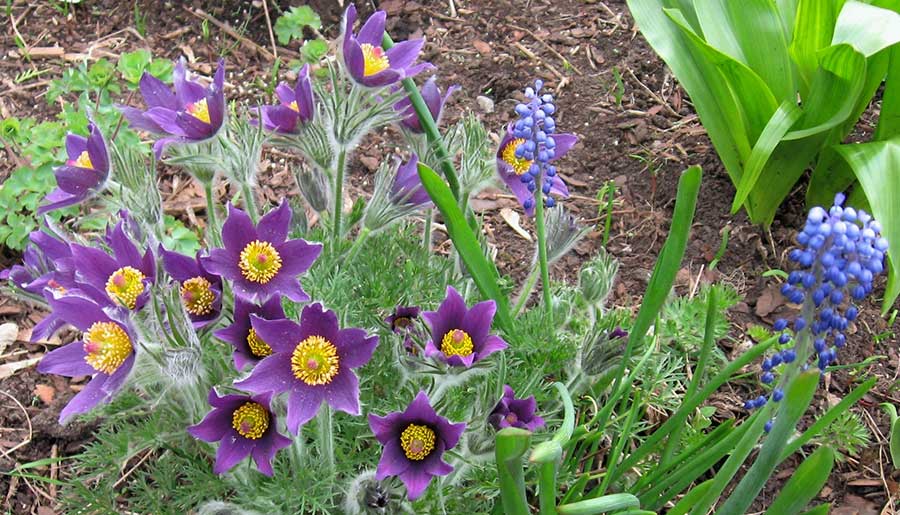
The prairie crocus (or “pasqueflower”) often bursts into bloom before the last traces of winter snow have melted. It bears sumptuous cup-shaped lavender-purple flowers held above finely dissected fern-like leaves, and even after blooming, its fluffy silver seedheads (or “achenes”) remain attractive for many weeks. This year, my specimens began to flower with the grape hyacinths, and after more than six weeks of continuous colour, their stems are only now beginning to elongate in preparation for seed production and dispersal.
The floral emblem of Manitoba since 1906, the prairie crocus (Pulsatilla patens syn. Anemone patens, Zone 2) is indigenous to most of the temperate Northern Hemisphere. In Canada, its native range extends from northwestern Ontario to British Columbia, north to Yukon and the Northwest Territories. Most experts agree that 12,000 years ago — while most of Canada was being scraped bare by mile-high glaciers — the prairie crocus survived in an unglaciated area called Beringia, part of present-day Alaska, Yukon and the Northwest Territories.
In gardens, prairie crocuses generally grow about 12 inches (30 cm) tall and wide and should be planted in full sun to part shade in good garden soil that drains efficiently. Living as long as 50 years, prairie crocuses develop a thick taproot, making them difficult to transplant or divide, so buy them young, decide on a permanent site and then leave them alone. I grow mine at the front of a large herbaceous border where their glossy two-inch (5-cm)-wide flowers aren’t obscured by taller perennials or spring bulbs. They’re also well-suited to rock gardens.
Many of the “pasqueflowers” available at Canadian nurseries aren’t true prairie crocuses, but are instead the closely related European Pulsatilla vulgaris (syn. Anemone pulsatilla), hardy to Zone 4. This is especially true of plants that bear white (e.g., Pinwheel White) or red (‘Röde Klokke’) flowers. Because the two species are so similar in appearance, in your garden the overall visual effect will be virtually the same, although I’ve found that our native species is more vigorous and floriferous than some of the European cultivars I’ve tried.
The prairie crocus has adapted to its harsh environment in sundry ingenious ways. The crown of the plant (that contains the leaf and flower buds) is flat and horizontal at the soil surface, making it difficult for foraging cattle to damage clumps significantly. Furthermore, when prairie grazers (including once-common woolly mammoths and buffaloes) step on the crowns of prairie crocuses, adventitious underground buds are stimulated, which in turn generate new, genetically identical leafy rosettes near the parent plant — an exceptionally nifty method of vegetative (or “asexual”) reproduction. (I’m dying to try this myself!)
Another remarkable adaptation is the ability of the prairie crocus to capture and store solar heat. The saucer-shaped blooms have highly reflective sepals (or “petals”) that concentrate the sun’s rays toward the centre of the flower; this additional warmth promotes self-fertilization and speeds seed development. As well, prairie crocus blooms are usually “heliotropic” (like sunflowers), meaning that their flowers move to face the sun as it travels across the sky, maximizing their exposure to solar radiation as they do so.
Finally, to conserve daytime heat buildup and further aid pollination, the blooms close at night, providing insects with a warm refuge on chilly evenings, enveloped as they are in a balmy floral embrace. Goodness knows what they get up to on clear, moonlit nights. Small wonder then that the temperature inside a prairie crocus flower can be up to 10°C warmer than the surrounding air.
An altogether amazing perennial by anyone’s yardstick.
Share your comments
Do you grow prairie crocuses in your Canada 150 garden?










I just finished a painting of the ‘Prairie crocus’. In one of our previous gardens we had over 100 native species and were getting ride of 400 sq. ft. of grass a year. Sadly the person who
bought the house grassed it all in. Miriam at the Wildflower farm is always helpful.
Jeff Mason of Mason House Gardens, Uxbridge may also have some. [email protected]
Where to buy this prairie crocus in Toronto/Scafrborough ON.?
I checked Flowersrus web site but did not see these crocus bulbs listed.
Thank you for your comment, John. I probably should have made it clearer, but the “prairie crocus” isn’t related to the small spring-flowering “true” crocus bulbs (corms) that we plant in the fall (Crocus spp. and cvs.). “Prairie crocus” and “pasqueflower” are just common names for Pulsatilla spp. and cvs. which are herbaceous perennials. This is why horticulturists aren’t generally keen on common names, as they can cause so much confusion.
To answer your question, you can buy seeds for Pulsatilla patens (prairie crocus) from the good folks at wildflowerfarm.com (near Barrie, ON); growing these plants from seed is the best way to establish them as they resent disturbance. Sheridan Nurseries at 1774 Ellesmere Rd, Scarborough, should be able to help you out with Pulsatilla cvs. (pasqueflowers) in general.
Happy gardening!